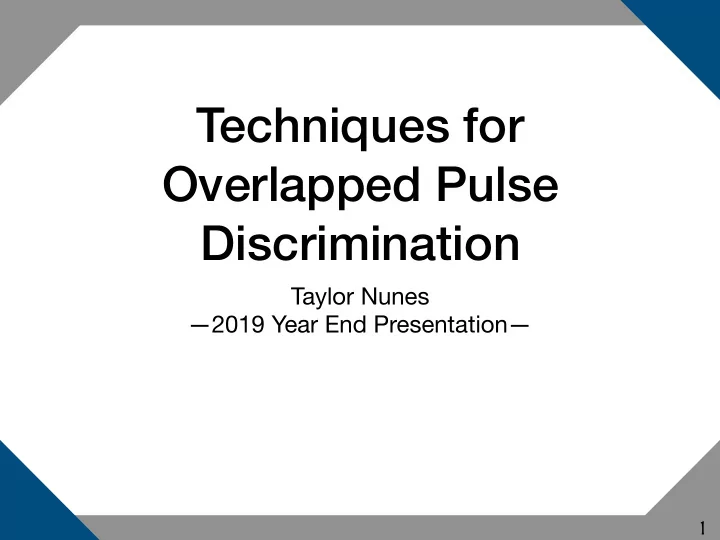

Techniques for Overlapped Pulse Discrimination Taylor Nunes —2019 Year End Presentation— 1
Motivation Scintillators or CsI Crystals • Some detectors have a high rate of accidentals Photomultiplier Tubes • Possibility of multiple decays in the same time ADC 2
Motivation • Based on when the Kaon decays, the signal is expected to fall inside a certain timing range (veto window) • Accidental hits that occur at similar times as the signal can alter the waveform • Can shift the peak, causing it to be outside the veto window • Detect and separate waveform into its individual components Veto Window ClockTime 3
Sample Generation • Generated individual gaussian pulses over a 64 element array • Combined individual pulses to generate a masked waveform • ‘Desired Peak’ was held constant • (time = 31.5 clock, height = 100 ) • ‘Masking Peak’ was varied from: ~120,000 waveforms • (time = 1 to 62 clock) • (height = 100 to 20,000) Masking Peak • • For each ‘Masking Peak’ a random number within [-0.5, 0.5] Desired Peak was added to time to vary phase 4
Peak to Area Comparison Method • Single pulse waveforms should have a constant Area ratio Peak • Overlapped pulse waveforms will have a larger Area ratio Peak corresponding to: H 0 • Individual peak height ratio - H 1 • Absolute value of peak timing di ff erence- Δ Time H 1 Δ Time H 0 ClockTime 5
Peak Calculation • For each point ( t ), checked if height[ t ] was larger than height[ t - 1 ] and larger than height[ t + 1 ] • Two methods 1. Selected height[ t ] as the peak height and t as peak time (Highest Point) 2. Used the two nearest points to calculate the vertex of a parabola. (Parabola Fitting) Vertex of 3-point parabola Datapoints 6
Peak Calculation Area ratio for Single Pulse Distributions Peak Highest Point Parabola Fitting Count Count Area Area Peak Peak 7
All Overlapped Waveforms Area Peak ( Desired Peak ) H 0 ( Masking Peak ) H 1 Δ Time 8
Area reduction from Area Peak Ratio for Overlapped Peaks waveform being cut o ff H 0 H 1 ClockTime Δ Time Reduction from peaks lining up ClockTime 9
Waveforms with Only One Peak Removed all waveforms that had Count 2 definitive peaks Area Peak 10
Waveforms with Only One Peak Area Peak ( Desired Peak ) H 0 ( Masking Peak ) H 1 Δ Time 11
Next Steps • Check distributions with noise • Replace gaussian with a more accurate representation • Check other discrimination methods that can decompose the waveform into its separate components 12
Backup 13
Count Δ Time Area Peak 14
Recommend
More recommend